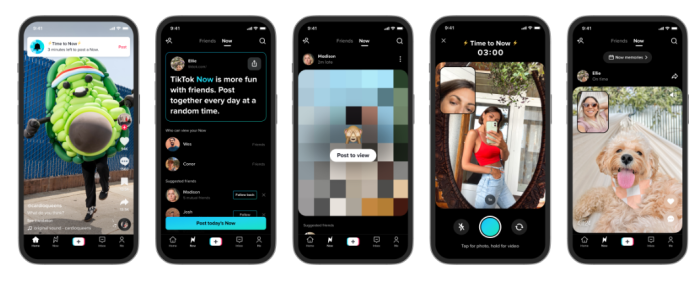How can you boost the success of your social media strategy in 2023? By staying up to date on current trends and making sure your efforts match how users’ behaviors have adapted and changed.
By keeping up with the latest social trends, your school can better connect with its target audience and boost engagement and conversions. So what’s new in 2023? Here are six social media trends that can help your school better prepare for a successful social media strategy for schools in 2023!
1. Short-Form Video Content Continues to Be a Top Trend
Video has been the dominant content format in digital marketing for years. As we continue to gravitate towards visually-driven content, the popularity of video will remain one of the top social media trends of 2023 for schools. In fact, recent research shows that 93% of marketers plan to use video marketing over the next several years compared to 82% of marketers from the previous year.
In addition to developing a video content marketing strategy, schools will need to feature video content on their social media accounts. New research also shows that 29% of marketers plan to enter YouTube for the first time in 2023, compared to 26% who are entering TikTok instead.
Here are some statistics to show just how impactful YouTube can be:
- YouTube is the world’s second most visited website, boasting 14.3 billion monthly visits. That’s more than Facebook, Wikipedia, Amazon, and Instagram!
- YouTube shorts alone has surpassed 15 billion daily views
- YouTube ads have the potential to reach 2.56 billion users—that’s 32% of the total population and 51% of the total internet users
Instagram Reels and Bite-Sized Content Continue to Play a Crucial Role
Many school marketers already use video to attract target audiences, and Instagram continues to be a great way to reach younger audiences. Statistics show that Instagram is still the preferred channel among 16 to 24-year-olds and that Reels grey by 220 million users between July and October alone. This makes the platform incredibly important for schools looking to reach their target audience better and boost engagement. Besides, the visual nature of the channel makes it ideal for showcasing the vibrancy of your school’s campus and community.
Example: In the spirit of the holidays, Edinburgh University created a video that showcases the beauty of the city. Prospects, especially those from abroad, can peek into life in a new environment and discover what it might be like to live there, all in a few seconds:


Source: Instagram
Short Instagram Stories and Reels also reflect the trend to prefer bite-sized content. By creatively presenting, curating, and promoting short video content, your school can begin building an engaged audience and cultivating a stronger sense of community, all while generating a higher ROI. Part of these efforts can also include sharing unfiltered posts that focus on real stories and authentic experiences, and user-generated content. Interestingly, it’s this type of user-generated content that can help boost your school’s success in 2023, especially considering that users are 2.4 times more likely to view this type of content.
Interested in taking your school’s content strategy to a new level in the new year? Reach out to our team for personalized support and insight on developing your inbound marketing strategy!
Facebook Stories and Videos are Growing Social Media Trends for Schools in 2023
In the next few years, Facebook Stories are expected to get bigger and better. It will become a proper feature in 2023, changing how users share everyday events with their friends. These Stories take place in real-time and will offer schools new and exciting opportunities to connect with their prospects.
Facebook is also capitalizing on the rise of video by upgrading and testing new video features. Video lengths will increase to accommodate users who want to watch long-form videos, and testing has already been done to evaluate the possibility of providing videos for offline viewing. As videos make up a big portion of consumer internet traffic, we’ll likely see Facebook shift more of its resources toward video.
Schools with a Facebook presence can get a head start by creating video content that resonates with their prospects. The video below is a fun example of how Boston University uses Facebook videos to do precisely that:
While social platforms used to be about connecting with friends and family, those days are over. Now, most users turn to social to discover content from people they don’t know. Facebook’s social algorithms are now using AI (Artificial Intelligence) to recommend users far more content from Pages and people they don’t follow. This Facebook trend derives from TikTok’s algorithm, which aims to show users the best content from all other users. It can also potentially provide content creators with even more exposure, giving schools the chance to reach a wider audience.
2. Social Media Will Become the New Search Engine
Google has been the go-to search engine for years. But younger internet users are starting to shift away from Google in favor of social media. Google recently revealed that around 40% of young internet users, ages 18 to 24, turn to TikTok or Instagram instead of Google Maps or Search. This trend has been so noteworthy that a New York Times article refers to TikTok as “the New Search Engine” for Gen Z. Below is a graph showing the increasing popularity of social media as a search engine for those 16 to 24 years old:


Source: We Are Social
In the past, SEO typically revolved around website optimization. As social media becomes the new search engine, SEO will likely be a required effort on social media. Interestingly, Hootsuite’s research shows that using keyword-optimized captions instead of hashtags increased reach by 30% and doubled engagement. These results create an opportunity for schools to experiment with social SEO, especially since the target audience is likely using social media to learn more about them.
Example: Toronto Metropolitan University’s undergraduate admissions team has a dedicated TikTok account that features valuable information and tips for prospects. The video below is a helpful guide that introduces key scholarship information to potential applicants:


Source: TikTok
By applying social SEO and using keyword-heavy captions and titles, these types of videos will gain even more views, becoming more easily discoverable as they provide value to their audience while also capitalizing on new social media trends for schools in 2023.
3. Niches and Nano Influencers are New Social Media Trends for Schools in 2023
According to HubSpot’s 2023 Marketing Strategy and Trends Report, boosting brand awareness and reaching new audiences are listed among marketers’ top three goals. This objective is driving a new approach forward–one that relies on influencer marketing as one of the top social media trends. The same report shows that 89% of marketers plan to increase their influencer budget in 2023 and that it provides a high ROI, second only to short-form video:


Source: HubSpot
However, unlike in previous years, the focus is now on nano and micro influencers instead of macro influencers. By collaborating with smaller influencers, brands can deliver more authentic content that resonates with niche audiences while also providing them with value. These influencers generally respond to their followers and have a stronger sense of community, which naturally generates high engagement. In fact, it’s been shown that nano influencers achieve more than double the engagement rate of macro influencers, with the average being around 3.69%.
A great way to capitalize on this trend is to create student ambassador programs and spotlight social media-savvy students. Involving actual students in various types of content can help you create authentic conversations about your school, its programs, and other relevant issues for prospects. It can also be a way for your school to connect more strongly with them. Embracing influencer marketing by focusing on niche audiences and student influencers can be one of the most impactful 2023 social media trends for schools.
Example: The University of Brighton does a great job featuring its students on its YouTube channel. In the video below, a student shares tips and advice for university preparation. This video can be particularly helpful to prospects getting ready to start university, providing them with value while also introducing them to the University of Brighton:


4. TikTok is Poised to Be the Number One Social Media Channel in 2023
In addition to being a go-to channel for online search, slowly overtaking Google, TikTok has been making big changes. The platform has been testing seven features to become a “super app,” an app that serves as a one-stop shop for social media, messaging, online services, and payments. Not only do these features include more traditional social media functions like carousels and stories, but they also include search ads and music.
TikTok advertising is also experiencing a notable boom. According to Google Trends, interest in TikTok Ads has been consistently increasing over the past few years:


Source: Google Trends
This rise also matches the high ad revenue experts expect TikTok to generate, reaching US $23.58 billion by 2024—about the same level as YouTube’s ad revenue. As a result of these social media trends for educational institutions, more schools may want to consider TikTok as part of their social media advertising strategy.
Example: The Universidad Autónoma de Guadalajara (UAG) School of Medicine, powered by Arizona State University, began a Lead Generation campaign on TikTok, targeting 18 to 34-year-olds interested in higher education, oversees education and language training:


Source: TikTok
By featuring real students and their experiences in short video ads, the school generated great results: a 2.1% conversion rate, a total reach of 1.3 million, and a total of 1.21 million video views. They also saw cost per click (CPC) lowered by 80%, cost per mille (CPM) by 50%, and cost per action (CPA) by 88%. These results have motivated the UAG School of Medicine to invest in a full-funnel strategy on TikTok.
Note: TikTok has been testing various features that will help position it further ahead in the social SEO sphere. It launched a local feed feature for “nearby” content and increased the video caption limit to 2,200 characters, boosting searchability.
5. LinkedIn is Expanding as a Space for Sharing Videos and Experiences
Unlike other social media networks, LinkedIn is typically used for more professional purposes. This often leads to users browsing the news, keeping up with industry developments, or researching brands and products. However, there seems to be an interest in sharing photos and videos on LinkedIn, with short videos and SlideShare content becoming even more widespread on the channel.
Since the typical focus on LinkedIn is lead generation and not e-commerce, social media activity often revolves around social selling. This leads brands to use the platform for sharing personal experiences, highlighting employees, and promoting inclusion. Schools with a LinkedIn presence can capitalize on this rising trend by sharing an insider perspective and spotlighting their admissions team or faculty.
Example: Audencia Business School uses many of these techniques to engage its target audience on LinkedIn. The first image shows a SlideShare highlighting the five benefits of earning a BBA in Big Data and Management at the school, while the second image shares an introduction of the school’s head of the marketing department:




Source: LinkedIn
These approaches make the school more inviting and easy to connect with, particularly as professional prospects dive into researching their higher education options.
It’s worth noting that LinkedIn is still a valuable platform for schools targeting prospects seeking career training and higher education. Although many platforms dominate social media trends for education, LinkedIn remains capable of reaching 14.6% of the world’s population. Unlike other potential audiences, the ones targeted on this platform are already primed to resonate with a school’s content. That’s especially the case since LinkedIn naturally attracts career-driven individuals seeking education opportunities.
6. The Need for Authentic Content Will Drive Social Media Trends for Schools in 2023
As seen with the shift towards nano influencers, there’s a growing need for authenticity and unfiltered content. The goal here is to share something personal and real, showcasing true experiences and stories instead of polished content. It’s what inspired the BeReal app and is what’s keeping it trending.
BeReal is rising in popularity at an incredibly quick rate, boasting over 56 million downloads as of this writing. In fact, it’s already being used monthly by nearly one-third of US teens:


Source: Insider Intelligence
The app asks users to share a photo at different times each day within a 2-minute window. The idea is to “be real” and post something in the moment or risk being labeled late if you pass the time limit. Users can only share photos when prompted, using the dual front and back camera format, and cannot post anything else. Instead of followers, users share content amongst friends, making the app feel more personal and intimate.
The need for authenticity has been so influential that the BeReal photo-sharing model has already been incorporated into other platforms. For instance, TikTok recently introduced TikTok Now to offer its users a chance to share spontaneous and authentic 10-second videos or photos based on a prompt at a random time in the day:


Source: TikTok Newsroom
Schools looking to promote themselves in fun and new ways can explore the BeReal app or simply try out this unique photo-sharing model. By exploring these social media trends for schools in 2023, you can better connect with your audience, showcase your school in a more authentic light, and generate a higher ROI.

